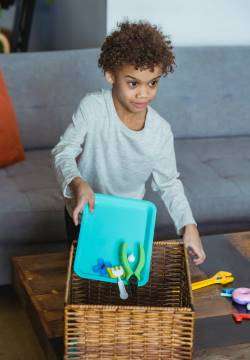Understanding proper behavior can be challenging for children, especially in a world where social conflict is common. As parents and teachers, we strive to model positive behavior and teach kids about good manners, but children may sometimes feel unsure about what is appropriate in different social situations. To help guide them, here are some effective tips for teaching children good manners and encouraging respectful behavior in social settings.
Instruct kids to Hold a Door for Others.

Children are often in a rush, but when they feel responsible for holding the door for their parents or siblings, it encourages them to slow down and develop empathy by thinking about others.
You can tell your son that you’re always grateful when people hold doors open for you, so he should do the same. It’s also good to teach kids not to run through entranceways themselves since this could accidentally slam into another person who might be entering behind them.
This is an exercise that isn’t only useful practically speaking but also emotionally.
The more our children learn to respect others’ time and space by teaching manners, the more chances there are for positive exchanges between individuals.
Holding a door open shows kindness towards those behind us and helps us feel like we’re doing our part as good citizens by making society better overall. Teach your children always to hold a door for others so they can instill this behavior from a young age.
Teach Kids to Say Please and Thank You.
You’ve likely heard the phrase, “Good manners will open doors.” This quote couldn’t be truer. Even as adults, we appreciate and admire those who know how to behave properly in social settings. Kids should learn that saying please and thank you is an essential part of life.
Set an example for children by being polite yourself and encouraging them to do the same. When they learn from a young age that manners are not just nice but necessary, they’ll be more likely to abide by the rules when they’re older.
When someone offers a four-year-old child a gift, it is common for parents to point out that “What do you say now?” Before this, the son, almost reluctantly and in a low voice, say another “thank you.”
It doesn’t matter if we have to repeat it many times. What’s more, there will come a time when he will not only automate it but he will realize what he achieves.
For example, when he asks for the materials “please” in class, the little one may discover that a classmate offers them with a smile. In turn, by expressing appreciation, the other will respond with kindness. All of this fosters powerful connections based on positive emotions.
This transition between giving thanks in an obligatory way until the child himself does it spontaneously and with pleasure is a wonderful process that will improve his life. These gestures add warmth to interactions and also make interactions easier.
Every Time your Kid does Something Kind for Someone else, Give him/her a Sticker.
When he/she has seven stickers, give him/her a prize. This doesn’t only help children learn good manners and makes them more aware of how important it is to be kind and caring towards others.
It is also a good idea to share privileges with your children. You could let them stay up for an extra hour if they’ve been particularly nice that day or give them an extra portion of dessert if they’re especially helpful to their siblings.
Parents should always remind children how lucky they are to be able to go outside and play instead of just sitting in front of the television watching TV series all day long. Kids need to know that not everyone has the same opportunities as them.
They should know it’s about sharing these things, so by giving others something special; children will feel proud of themselves. This kind of thinking brings us closer because we value relationships more highly than materialistic objects.
Talk About Manners at Mealtimes.

If you want your kid to sit at the table properly, ensure he sits up straight when eating meals from a plate rather than slumping his food from a bowl. He’ll also need help learning where to put his napkin and how to hold his cutlery.
When your child eats too quickly, it might be a sign that he hasn’t enjoyed the experience enough. If you struggle with this issue, try to take things slower, and encourage him/her to eat at least one mouthful of each food on his/her plate before taking another bite.
This will help ensure our little ones truly appreciate their meal instead of rushing through it as fast as possible so they can get out of there as soon as possible or play some more!
We’ll always remember when we were children and shared meals with family members.
These experiences offer plenty of opportunities to sit around the table and discuss what we’ve been up to throughout the day. Manners are important at mealtimes because this is when we can step away from our busy schedules and show our appreciation for each other.
When training children about table manners, parents should help them learn how to hold their cutlery properly (i.e., by placing the tips on their pointer fingers). Parents can also remind kids not to make noises like smacking or slurping, as that can be bad manners and may make others feel uncomfortable.
When teaching children about table manners, it’s important to teach them how to chew with their mouths closed.
It’s also a good idea to ask your child: ‘How would you like someone else to eat/talk when they’re at the table with you?’ and help them come up with an answer if necessary.
Remember: we should always look out for those around us because we don’t want our youngsters to put off other people by behaving in ways that are not acceptable. By teaching kids good behavior, we will help build stronger relationships among friends and family members, which is better for everyone!
Teach Them Not to Interrupt People While They’re Talking.
If children constantly interrupt adults while speaking, parents should explain that it’s inappropriate to talk over others like this. Furthermore, we can help our kids learn to listen carefully by encouraging them to look at whoever is talking and keep quiet until the speaker has finished what he/she has to say.
If you want your kid to stop interrupting people when he/she speaks, it’s a good idea to show him/her your own behavior and how it’s done. Ensure that during conversations around the table, you avoid making loud noises so as not to disturb others speaking with one another.
Ensure your child says “excuse me” when they want to interrupt someone else’s conversation.
If need be, you can also tell your children that if they want to interrupt someone else’s conversation, they should wait until the person has finished talking and then say “excuse me” before speaking.
When teaching children about good manners in conversation, start by asking them questions when they speak so they can listen carefully to what you have to say. This way, your son or daughter will be more receptive to listening carefully when others are speaking and not interrupting them so much.
When having conversations with our children, we must help them learn how to speak at an appropriate volume. It can sometimes be hard for parents to hear what their kids say over background noise in restaurants, but raising your voice is not ideal either.
Wait Your Turn in Line.

Waiting for our turn is something that many of us have to do on a regular basis. Whether waiting in line at the grocery store, at the school drop-off, or when driving on the road, being patient while others are around us is essential. It can be frustrating if we’re trying to get somewhere fast and there’s too much traffic, so it’s important not to take our frustrations out on others.
If you want your child to understand how annoying it can be when they don’t wait their turn, try giving them examples of times when they have been impatient themselves. This will help kids understand other people’s feelings during these situations.
If your child needs guidance about patience under pressure, you might tell them stories about yourself when you’ve had to wait your turn.
For example, did they remember when you were in the middle of an errand but couldn’t leave until someone else got their order? Tell your child that it’s important to be aware of how others are feeling during these situations because impatience can make us feel bad for upsetting other people.
Once our children understand what it feels like to be on the receiving end of bad behavior, we can explain that waiting your turn is something that’s good manners for everyone. It’s important to teach kids not to cut lines or push past other people while waiting in line to not cause anyone else any trouble.
Respect Other People’s Property and Feelings.
It’s important to teach our kids the importance of respect, especially regarding other people’s possessions and feelings. When teaching your child about respecting others, you should start by teaching them that if they don’t want to be disrespected, they shouldn’t disrespect anyone else.
Whenever we’re around other people, chances are certain things belong to us but may not belong to them. Children need guidance in understanding this concept because otherwise, they will think that anything is fair game if it doesn’t belong to someone else at the time.
Parents can help their children identify what belongs to everyone versus what belongs only to someone in particular by highlighting how our personal property is kept safe behind locked doors or drawers, but other people’s things are left out in the open.
When it comes to respecting others, we need to talk about how our words can hurt someone else’s feelings.
When kids are young, they don’t fully understand the emotions that others feel when they say something mean or downright rude. They may not know that teasing their friends or siblings can make them feel bad inside.
If your child is picking on another kid at school, take the time to explain why this isn’t okay. Tell them that there are times when saying things like “that doesn’t look good” or “you’re annoying me” may be acceptable in certain situations, but making fun of others for who they are or what they do isn’t okay.
Also, remind them that showing good manners means respecting others even when they don’t like them because all humans need to learn how to get along. Ensure you give examples from those around you so as not to use clichés or preachy phrases. Good manners are not just something we say but also something we show.
Teach Them to Apologize When They are Wrong.
The main way for parents to educate their children is to be models of what they intend to teach. Therefore, if you want your child to be grateful, thank (neighbors, your partner … and him or her!). In the same way, if you want him to learn to ask for forgiveness, be a good model of humility and apologize when you make a mistake or hurt someone.
And again, ask your own son for forgiveness. Some parents don’t do it out of fear of losing their “authority,” but the reality is that we all make mistakes, and acknowledging our mistakes helps us make amends.
We also make mistakes with our children (e.g., we speak badly to them, we punish them disproportionately, we give them a push because we are in a hurry …), and apologizing is the best way for them to see apologies as something perfectly natural that forms part of a healthy and respectful coexistence. It will also teach them to feel valuable and worthy of respect, even in other situations, as they will have found that others must treat them well.
This is very valuable learning for them to enforce their rights in other places (e.g., with friends or at school) and to increase their self-esteem.
Make sure that the apologies make sense:
That something has bothered you; it did not turn out the way you would like it, etc. It does not mean that your child acted on purpose or that he should apologize. Before asking your child for explanations, make sure that it is inappropriate (and not simply something that you do not like or that made you feel bad today because you were in a worse mood) and, most importantly, that you can control it.
This implies understanding that a child is a child (he needs to move more, there are things he does not have to know yet, he is still maturing, etc.) and asking him only those things that are reasonable for his age and in accordance with the explicit rules that we have established at home.
Put him in contact with the consequences of his behavior:
Sometimes, children are unaware that their behavior is inappropriate because we resort to scolding or arbitrary punishments that have nothing to do with what happened, which prevents the child from understanding why his actions have been so upsetting to his parents or others. Depending on the child’s age, it is possible to do certain things to help him or understand why her behavior has been annoying or problematic.
For example, if he has said something nasty or aggressive to me, I can express to him that I am sad or disappointed. If he has damaged something, he can accompany me to repair it, to buy a replacement, or, if he has savings, he can contribute a part to replace what has been damaged. If you have damaged a toy, I can avoid changing or replacing it immediately. We can do this calmly and without falling into emotional blackmail in order to make him understand how the world in which he lives works.
Do not expect immediate apologies:
When we are nervous, it is very common to become defensive, and our first reaction is to protect ourselves. In addition, precisely because it is a very emotional moment, sometimes it is difficult to reason and see things in perspective.
If this happens to us even as adults, imagine how difficult it can be for children to analyze the situation as “hot”. So it may be better to wait for tempers to calm down and only then return to the subject and talk to him about what happened and how to fix it. Pressuring you to apologize or be reasonable at that point will only make things worse and make us all more nervous and “stubborn.”
Accept their apologies in a loving way:
Sometimes, the tension of the moment, pride, or the need to vent lead to that when the child finally apologizes, our reaction is to continue talking about what has gone wrong and scolding him for his behavior. It is very important to restrain ourselves and do the opposite: if your child apologizes or tries to make amends, you must be receptive and accept his good intentions willingly, as it is an important effort and learning for him. Thank you for the gesture!
Put Things Back Where They Belong When Finished With Them

If we want our child to be more respectful and tidy, the best thing is to teach him from a young age to put things back where they belong when finished using them. This way, he will gain an understanding of the basic values of respect for others’ property.
In addition, teaching your child not to leave things in disorder or leave his toys in their original place will help him develop skills such as taking turns, sharing, and patience with others.
To do this, children must learn by doing:
Playing at home, let them participate with you when you return objects to their respective places (e.g., contain toys, make beds …).
Children learn with their parents, and it is very interesting (and fun) that they know how to return things where they belong when we do the same. If you return an object where it should be, your child will get used to doing the same whenever he has finished using something.
But if you keep putting things about or out of order, your child will learn that this is allowed because his parents do not worry about it! Again, imitation comes first.
Among other things, this habit teaches children to take care of objects and avoid wasting them; To plan ahead; And develop self-esteem: looking for an object in its place makes us feel like something important (“Now I look for my X”), and we feel proud of our effort and achievement.
Make a cleaning game with your child!
Give him a basket or box and let him look for objects around the house and store them. This will help you to train together and at the same time will be fun for him!
In addition, encourage your child to build boxes to keep toys in their room, as it is also an opportunity to teach those qualities listed above. Give tips on how to begin the box, how tall it should be, etc., as he can do it with his own little hands if you tell him what you need and show him where all the pieces are. A creative process always develops concentration and planning skills !!!
Teach Them to Be Honest, Don’t Lie or Cheat
Children learn by imitation. Therefore, they need to see us as honest people who do not lie or cheat and that the other person’s word has value and should be respected. If they observe that we are often dishonest or lack respect for others’ rights (e.g., if we say something bad about someone else), this may result in poor moral values and low self-esteem, among other things.
If children suspect that lying would solve their problems or avoid the negative consequences of their behavior or mistakes, they will start lying without even thinking about it. And once you’ve started making up stories so easily, it is difficult to stop doing so because your conscience does not always help you to tell the truth. It takes courage to tell the truth!
In many cases, children do not clearly know what is considered lying.
Let’s help them to discover that by explaining to him that both small and big lies (“I did it and I can not do it anymore”; “I was on time and the bus broke down”) are wrong because they hurt others and we must always be respectful of their feelings.
If we lie, we will teach our children to lie, too.
Parents often think that as long as they do not lie or cheat with their children, telling them that something has happened when it hasn’t. But this is a very common mistake! Children learn from how we act before they learn from what we say. Therefore, even if you do not intend to teach your child that it is all right to lie, you are teaching him exactly that by doing so with him!
Conclusion.
We hope these 10 ideas will help you teach your children good manners. Maybe one or two of them are something new, but most likely, they should be taught to every child at a very young age.
It doesn’t take much time and can make all the difference in how your kids act when they grow up. Have you used any of these tips with success? Share what’s been helpful for you!

Meet Brenda Tillman: your go-to expert in Cognitive Behavioral Therapy! Not only is she a seasoned therapist, but she’s also a passionate mom blogger who never misses a beat. Dive deep into her insightful blogs, backed by her extensive coursework in Parenting Skills, Learning, and Education. Brenda’s heartwarming family – a son, two daughters, and their adorable pets – often take center stage in her writings. From parenting hacks and relationship tips to health & fitness nuggets, Brenda has been enlightening her readers for over half a decade. Stick around, and you’re bound to discover gems from a mom who wears many hats with grace!
Reviewed By: Joanna Perez and Marcella Raskin
Edited By: Lenny Terra
Fact Checked By: Gabrielle J. Smith
Photos Taken or Curated By: Matthew Mansour